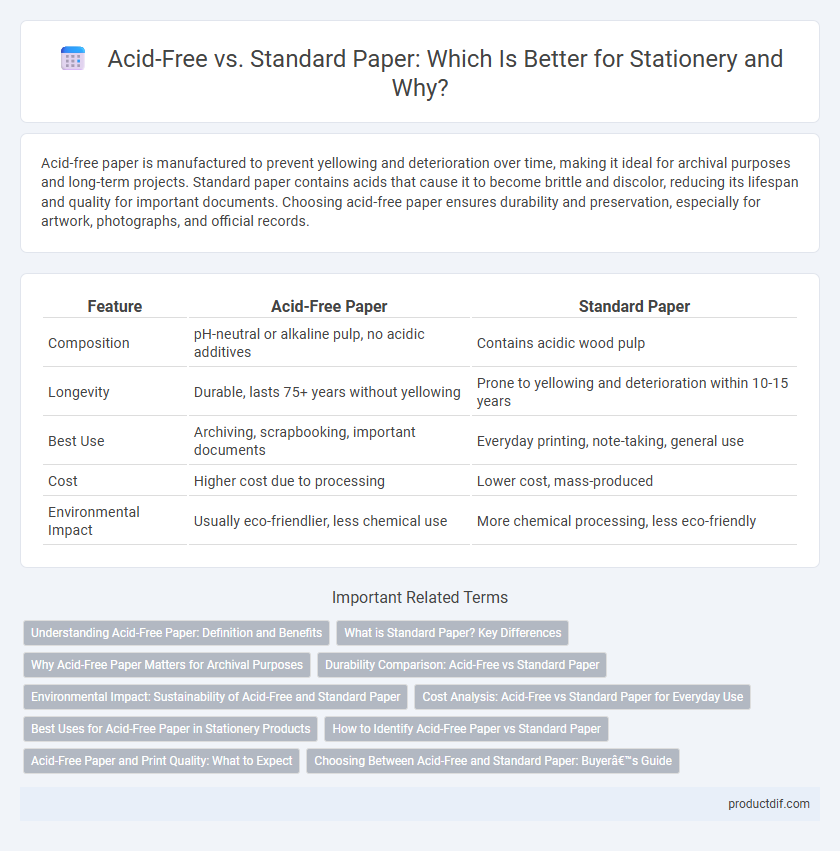Acid-free paper is manufactured to prevent yellowing and deterioration over time, making it ideal for archival purposes and long-term projects. Standard paper contains acids that cause it to become brittle and discolor, reducing its lifespan and quality for important documents. Choosing acid-free paper ensures durability and preservation, especially for artwork, photographs, and official records.
Table of Comparison
| Feature | Acid-Free Paper | Standard Paper |
|---|---|---|
| Composition | pH-neutral or alkaline pulp, no acidic additives | Contains acidic wood pulp |
| Longevity | Durable, lasts 75+ years without yellowing | Prone to yellowing and deterioration within 10-15 years |
| Best Use | Archiving, scrapbooking, important documents | Everyday printing, note-taking, general use |
| Cost | Higher cost due to processing | Lower cost, mass-produced |
| Environmental Impact | Usually eco-friendlier, less chemical use | More chemical processing, less eco-friendly |
Understanding Acid-Free Paper: Definition and Benefits
Acid-free paper is manufactured using neutral or alkaline pH processes to prevent yellowing and deterioration over time, making it ideal for archival and artistic purposes. Its longevity and resistance to environmental factors ensure the preservation of documents, photographs, and important records without fading or becoming brittle. Choosing acid-free paper enhances durability and maintains the integrity of printed materials, outperforming standard paper in terms of lifespan and quality.
What is Standard Paper? Key Differences
Standard paper is typically made from wood pulp and contains acidic compounds that can cause it to yellow and deteriorate over time. Unlike acid-free paper, which is buffered to neutralize acids, standard paper has a shorter lifespan and lower archival quality. The key differences include longevity, pH level, and suitability for important documents or artwork requiring preservation.
Why Acid-Free Paper Matters for Archival Purposes
Acid-free paper is essential for archival purposes because it resists yellowing, brittleness, and deterioration over time, ensuring long-term preservation of documents and artwork. Unlike standard paper, which contains acidic compounds that accelerate degradation, acid-free paper maintains its structural integrity for decades or even centuries. Museums, libraries, and archives prefer acid-free materials to safeguard historical records and valuable collections from irreversible damage caused by acid-based chemical breakdown.
Durability Comparison: Acid-Free vs Standard Paper
Acid-free paper offers superior durability compared to standard paper due to its neutral pH level, which prevents yellowing and brittleness over time. Standard paper contains acidic compounds that cause deterioration, weakening the fibers and reducing longevity. Archival-quality documents and artwork benefit from acid-free paper's resistance to environmental factors, ensuring preservation for decades.
Environmental Impact: Sustainability of Acid-Free and Standard Paper
Acid-free paper significantly reduces environmental impact by using fewer harmful chemicals and preventing faster degradation compared to standard paper, which often contains lignin and acids that contribute to pollution and landfill waste. The production of acid-free paper supports sustainability efforts through longer durability and recyclability, minimizing deforestation and resource consumption. Standard paper's shorter lifespan necessitates more frequent replacement, increasing carbon emissions and waste, whereas acid-free alternatives align better with eco-friendly practices and conservation goals.
Cost Analysis: Acid-Free vs Standard Paper for Everyday Use
Acid-free paper typically costs 20-30% more than standard paper due to its higher manufacturing quality and longevity benefits. While acid-free paper prevents yellowing and deterioration over time, making it ideal for archival or important documents, standard paper's lower price makes it more cost-effective for everyday printing and note-taking. Businesses and individuals should consider the trade-off between durability and upfront cost when selecting paper for routine use.
Best Uses for Acid-Free Paper in Stationery Products
Acid-free paper is ideal for archival-quality stationery products such as wedding invitations, certificates, and important correspondence that require long-term preservation without yellowing or deterioration. Its pH-neutral composition prevents chemical breakdown, making it perfect for scrapbooking, photo albums, and professional documents that need to maintain clarity and integrity over time. Standard paper, with its acidic content, is better suited for everyday printing and note-taking where longevity is not a primary concern.
How to Identify Acid-Free Paper vs Standard Paper
Acid-free paper can be identified by checking the pH level, which typically ranges from 7.0 to 9.5, indicating neutrality or slight alkalinity, whereas standard paper often has a pH below 7 due to acidic content. Look for labels or certifications such as "acid-free," "archival quality," or "lignin-free" on packaging, which guarantee long-lasting, non-yellowing paper suitable for preservation. A simple home test involves placing a small piece of paper in water; acid-free paper tends to remain intact longer without discoloration, unlike standard paper that might degrade or stain.
Acid-Free Paper and Print Quality: What to Expect
Acid-free paper offers superior print quality due to its neutral pH level, which prevents yellowing and deterioration over time, ensuring long-lasting, vibrant prints. This type of paper is ideal for archival documents, fine art prints, and professional presentations where clarity and color accuracy are critical. Compared to standard paper, acid-free options maintain their integrity and appearance, making them a preferred choice for high-quality printing applications.
Choosing Between Acid-Free and Standard Paper: Buyer’s Guide
Choose acid-free paper for archival-quality stationery that resists yellowing, ensuring longevity ideal for important documents and artwork. Standard paper offers a budget-friendly option but tends to degrade over time due to its acidic content, making it less suitable for preservation. Assess your project's purpose and durability needs when selecting between acid-free and standard paper to optimize quality and cost-effectiveness.
Acid-Free vs Standard Paper Infographic

 productdif.com
productdif.com